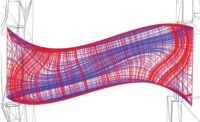In the center of Berlin, the Barenboim-Said Academy building is near the end of a radical three-year, $35-million makeover. During ENR's recent visit, the site itself offered a lesson in counterpoint: On one side of the 75-ft-tall atrium, a violin-piano-oboe trio played; on the other, a worker painted the walls to the accompaniment of metal being grinded and cut.
“There are about a thousand things left here to do,” says Michael Naumann, founding director of the academy and former German culture minister. “That’s not too bad.”
A key feature of the updated academy will be the Pierre Boulez Saal, a chamber-music performance space designed by Frank Gehry and Partners. Building assistance came from rw + architects and hg merz, a Berlin design firm specializing in remodeling listed buildings. Some 50 firms so far, from Germany and abroad, have brought specialized skills to the project team—for example, a Slovakian specialist who supplied flexible-plan bleachers to the San Antonio Spurs basketball team, Naumann says. At Barenboim-Said, the firm is installing motors that will help move the ground-level seating into a variety of configurations, depending on a given performance.
Scaffolding still covers a side street as the raw, exposed-brick exterior is refinished, plastered over and painted. While the tall, decorative doorways are nearly finished, plywood planks sit over dirt in front of four oversized, 12-ft wood panels. On a side street off Französische Straße across from St. Hedwig’s Cathedral in the heart of Berlin’s Mitte district, a similar arrangement is closer to completion, with only electric cable spilling out from a slot in one of the travertine columns. In the arch is an inscription from German philosopher Friedrich Nietzsche: “Ohne Musik wäre das Leben ein Irrtuum,” which translates as “Without music, life would be a mistake.”
This building has a history. The Barenboim-Said Academy is named after Daniel Barenboim, the Argentine-born pianist, conductor and music director of the Berlin Staatsoper, and Edward Said, the late literature professor with whom Barenboim founded the West-Eastern Divan Orchestra, which is made up of youth musicians from Israel and Arab nations. Already in its early operations, the academy eventually will bring in up to 90 students from the Middle East for a two-year study program. The Französische Straße entrance leads directly into the soaring atrium, which is capped by a peaked skylight and features a broad staircase that snakes its way around three stories. The students practice and work in rooms on the left side of the hall. On the other side is the Pierre Boulez Saal, the Gehry-designed performance spaced named after the influential postwar composer (and Barenboim’s friend) who died in last January.
The hall itself has a long connection with the nearby Staatsoper, a former court opera (1742), which, after World War II, served as the German Democratic Republic’s state opera. The bombed baroque theater was restored along with other structures on Unter den Linden. The Staatsoper stored its elaborate sets on a system of steel rails, tracks and girders in a 6,500-sq-meter depot. Now, this building is becoming the academy and Boulez Saal.
The Saal’s most visible and Gehry-esque features are two sinewy ellipses, the upper one, which weighs 320 tons, floating about 30 ft above the performing space. Both ellipses are placed concrete. To control placement and create the shapes, workers built a system of wood barriers to channel the fast-setting material. “They were like the avalanche barriers you see on mountains,” Baumann says. “There was a lot of ingenuity.” The huge forms for the ellipses were trucked in at night to avoid city traffic. The concrete is now being lined over. Connected to the exterior walls in only four places and held in place by hidden and coated steel girders, the mass weight will appear to be light.
To create this space, however, the architects and engineers first had to remove the roof and much of the track-and-girder system for the sets and the interior walls, which dated to the building’s last renovation. During the 1950s, German architect Richard Paulick, who was an assistant to Walter Gropius at the Bauhaus before World War II, helped to design the postwar buildings lining the Karl Marx Allee, East Berlin’s grand boulevard. Removing the Saal's internal structures, though, required crews to prop up the external walls of the depot, which is a historically protected building. Baumann says the solution involved constructing a tower inside the building, from top to bottom, and pinning the walls to it with steel girders. As hg merz's atrium took shape and the renovation went forward, the tower could be taken down slowly.
When the concert hall officially opens next spring—the program features Boulez, Schubert, Mozart, Alban Berg and Jörg Widmann—it will be an extremely flexible, adjustable performance space, says Saal Director Ole Baekhoej. With a capacity of about 650 people, the lower seating can be folded and wheeled around to accommodate a traditional stage setting, brought into the round for an intimate performance or pulled back for a larger ensemble. Sensors built into the seating modules on the floor will assist this choreography. “It gives us possibilities,” Baekhoej says. “It’s the hall of a music academy, so this is really useful. You can have a great variety of different kinds of performances.”
Pierre Boulez created compositions with complicated acoustical notations for echoes and duplicated sounds, for example. Acoustics are an important part of every music hall. For the Saal, the team tapped Yasuhisa Toyota, who designed the acoustics at Gehry’s Disney Hall in Los Angeles and with whom Baekhoej worked in the design of Copenhagen’s Radio Concert Hall. Forms for the poured-concrete ellipses, for instance, have open spaces underneath the seats. Like stereo speakers, they will be covered with fabric, providing surfaces to shape the sound of the hall.
The Oregon-pine ceiling panels are curved for acoustic purposes. Behind them sit boxes filled with sand, creating a heavy volume for the sound as it reaches the top. Underneath the players, however, the surfaces will be over hollow spaces, for resonance. Baekhoej is excited about it. “Toyota is a bit of a magician,” he says. “A visionary, open-minded fellow, with a lot of experience working in halls that are not traditional shoeboxes. It’s a mixture of artistry and craft.”







Post a comment to this article
Report Abusive Comment